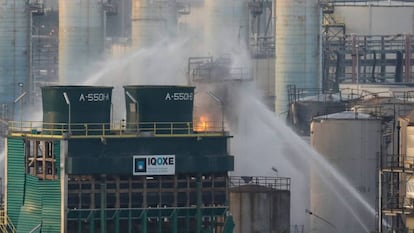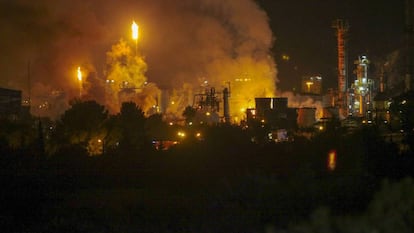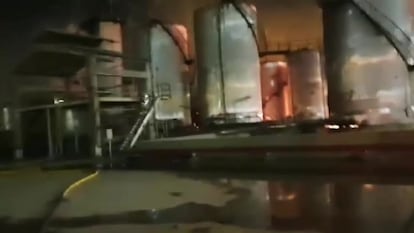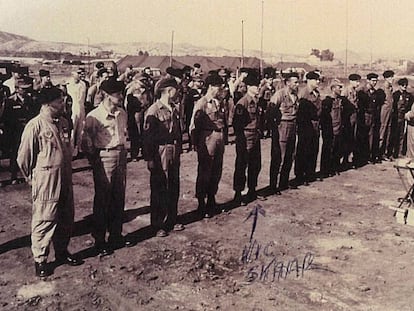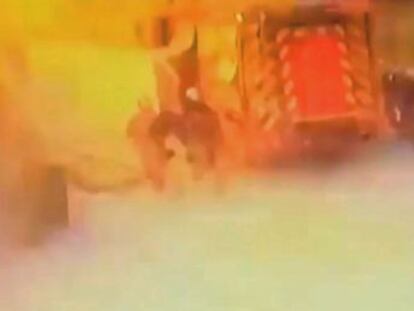Explosion at chemical plant in Spain kills two, injures eight
One of the victims died when a building several kilometers away partially collapsed as a result of the blast, which took place at an ethylene oxide facility in Tarragona
Two people are dead and eight more injured as a result of two explosions at a chemical plant in Tarragona, in Spain’s northeastern region of Catalonia. The blasts triggered a fire and caused a residential building located two kilometers away to partially collapse.
A 59-year-old man who was in his bedroom was crushed to death when the apartment above him collapsed after being hit by a one-ton piece of metal that went flying through the air from the force of the shockwave. Firefighters who found the item said it is probably a lid from the reactor at the plant. Eye witnesses had talked about a “ball of fire” flying through the air and crashing into a third-floor apartment. (see bottom box)
Continuem la investigació de l’accident mortal d’ahir en un pis a Torreforta. La peça metàl·lica que hauria impactat a l’edifici faria aproximadament 122x165x3 cm #Plaseqcat pic.twitter.com/GUPDcwuKkV
— Mossos (@mossos) January 15, 2020
The investigation continues into yesterday's deadly accident in an apartment in Torreforta. The metal piece that seems to have crashed into the building measures approximately 122x165x3 cm.
An employee who was missing was found dead on Wednesday morning. Another worker remains in critical condition, medical services have reported.
The blasts took place at Industrias Químicas de Óxido de Etileno (IQOXE), a company that produces ethylene oxide, a highly flammable gas that is used to make detergents, solvents and plastics, among other products.
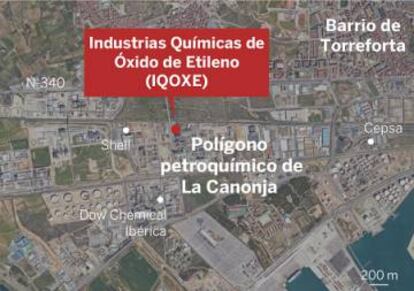
The first explosion took place at 6.40pm on Tuesday at the company plant in the Tarragona neighborhood of Torreforta, inside La Canonja Petrochemical Park, which is also home to Dow Chemicals Ibérica and the oil and gas multinational Cepsa. There was a second blast at a transformation station located at the plant, said the Catalan head of interior affairs, Miquel Buch.
The petrochemical park where the blasts took place is located in the triangle formed by the municipalities of Tarragona, Vilaseca and La Canonja. Soon later Civil Protection services issued alerts telling the residents of seven nearby municipalities to remain indoors, but the chemical accident systems were not activated, leading to some confusion. The Catalan government said that the company did not immediately alert authorities about the fact that there had been an explosion at the plant. “The first warnings came from citizens,” said a Civil Protection source.
The Catalan premier, Quim Torra, visited the area and sent out a similar message: “There is no toxic element.” Spain’s prime minister, Pedro Sánchez, said in a Twitter message that he has offered Torra “all necessary support.”
Firefighters were still battling the blaze in the early hours of Wednesday, and had contained the flames coming out of an ethylene oxide tank where the blast originated.
Railway service on the Tarragona-Reus and Tarragona-Port Aventura lines was canceled for over an hour on Tuesday, and roads near the site were cut off until 8pm.
Witness accounts
Maite Fonoll was inside a store located around two kilometers from the site when she heard an explosion. “The entire building shook. It was really strong,” she said over the phone. Customers immediately realized that something had happened at the petrochemical park. “And when something happens there, we all start to shake with fear.”
There were bottlenecks on roads as people sought to drive away from the area in a hurry. Fonoll said there were no noticeable smells, and that nobody around her had trouble breathing normally.
Source of the blast
UGT, the main labor union at the IQOXE plant, said that the explosion involved ethylene oxide and that it probably originated in or near the reactor.
According to the Health Ministry’s Public Heath Committee, exposure to ethylene oxide can cause respiratory and eye irritation, two symptoms that were reported in recent hours by some residents of Tarragona, Perafort, Reus and Salou. Civil Protection services said no toxic substances were detected in the air near the site of the explosions.
“Suddenly the front door flew open and the glass on the windows started to shake,” said Laura Paño, who works in the nearby town of Vilaseca. “Everyone rushed outdoors because they thought something had happened there. We didn’t hear any sounds. The first thing you think is that there has been an earthquake.”
Paño said that nobody came to tell them to what to do. “We are looking at official websites of the Mossos [Catalan police force] and they’re saying we have to stay indoors. The streets are deserted and all the stores have been closed.”
“The first thing I thought of was the ETA bomb of 1987,” said Antonio Carmona, who was at a hardware store four kilometers from the site, alluding to an attack on the Enpetrol refinery by the now-defunct Basque terrorist group. “People panicked. We know what it means to live in Vilaseca, but if it had been a chemical explosion, something serious would have happened, because alarms did not go off for 20 or 30 minutes. People were scared and there was a lack of information.”
Death two kilometers away
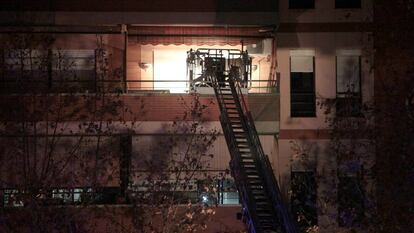
Sergio, 59, was well known in Torreforta. Until the economic crisis forced him to shut down his business, he had run a local fruit shop in this densely populated neighborhood of Tarragona. The blocks of residential buildings sit two kilometers away from the most important petrochemical compound in southern Europe: La Canonja industrial park, home to facilities run by some of the world’s leading chemical companies.
The approximately 8,000 residents of Torreforta are accustomed to the wails of emergency sirens once a year, when a chemical accident drill takes place. On Tuesday, after hearing two explosions, neighbors were puzzled at the lack of official messages.
But residents of an apartment building on García Lorca square heard something more: the floor cracking inside a third-story home that came crashing down on Sergio, who lived directly below.
On Wednesday, the mayor of Tarragona, Pau Ricomà, confirmed that the “most likely hypothesis” behind the death of Sergio was a panel that flew off the reactor that exploded. The piece of metal, measuring 122 by 165 by three centimeters, and weighing a ton, caused the collapse of the apartment, which came crashing down on Sergio below.
“A ball of fire” is the most commonly used description by eyewitnesses. Some said they saw an orange-hued object fly over the inner courtyard and hit the third-floor wall. “It was like a bomb,” said Antonia Mora, who lives on the first floor and who ran out thinking there had been a gas leak.
A father of two, Sergio was home alone because his wife had just gone out for a stroll with one of their young grandchildren. He was killed inside his bedroom.
With additional reporting by Bernat Coll, Javier Íñiguez, Josep Catà, Ivanna Vallespín, Laura Cercós and Rebeca Carranco.
English version by Susana Urra.
Tu suscripción se está usando en otro dispositivo
¿Quieres añadir otro usuario a tu suscripción?
Si continúas leyendo en este dispositivo, no se podrá leer en el otro.
FlechaTu suscripción se está usando en otro dispositivo y solo puedes acceder a EL PAÍS desde un dispositivo a la vez.
Si quieres compartir tu cuenta, cambia tu suscripción a la modalidad Premium, así podrás añadir otro usuario. Cada uno accederá con su propia cuenta de email, lo que os permitirá personalizar vuestra experiencia en EL PAÍS.
¿Tienes una suscripción de empresa? Accede aquí para contratar más cuentas.
En el caso de no saber quién está usando tu cuenta, te recomendamos cambiar tu contraseña aquí.
Si decides continuar compartiendo tu cuenta, este mensaje se mostrará en tu dispositivo y en el de la otra persona que está usando tu cuenta de forma indefinida, afectando a tu experiencia de lectura. Puedes consultar aquí los términos y condiciones de la suscripción digital.
More information
Archived In
Últimas noticias
Most viewed
- Reinhard Genzel, Nobel laureate in physics: ‘One-minute videos will never give you the truth’
- Oona Chaplin: ‘I told James Cameron that I was living in a treehouse and starting a permaculture project with a friend’
- Pablo Escobar’s hippos: A serious environmental problem, 40 years on
- Why we lost the habit of sleeping in two segments and how that changed our sense of time
- Chevy Chase, the beloved comedian who was a monster off camera: ‘Not everyone hated him, just the people who’ve worked with him’
